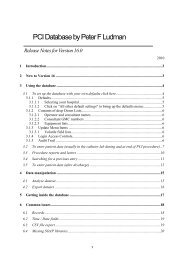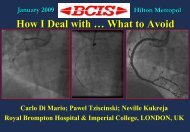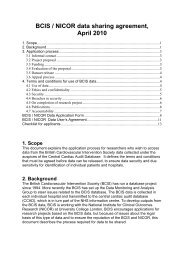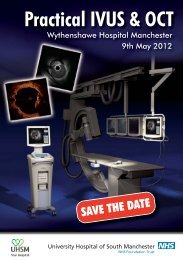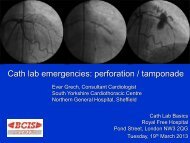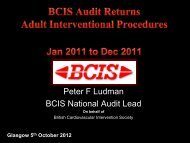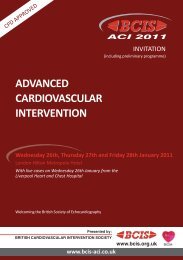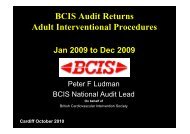Recommendations
ACC/AHA/SCAI PCI Guidelines - British Cardiovascular Intervention ...
ACC/AHA/SCAI PCI Guidelines - British Cardiovascular Intervention ...
- No tags were found...
Create successful ePaper yourself
Turn your PDF publications into a flip-book with our unique Google optimized e-Paper software.
ACC - www.acc.org<br />
AHA - www.americanheart.org<br />
SCAI - www.scai.org<br />
Smith et al. 2005<br />
ACC/AHA/SCAI Practice Guidelines<br />
35<br />
performed with a zero adverse event rate. It demonstrates<br />
that if 10 consecutive cases are performed without a complication,<br />
the upper bound of the 95% CI is 25%. If 50 cases<br />
are performed without an adverse event, the upper bound is<br />
5.8%.<br />
Thus, although it is likely that certain low-volume operators<br />
and institutions perform procedures with acceptable<br />
quality, satisfactory quality is difficult to prove unless a sufficient<br />
number of procedures are compiled for analysis. The<br />
quality-assessment process must take the above issues into<br />
consideration. This means that it is essential that institution<br />
and operator outcomes be tracked over sufficiently long<br />
periods of time to assemble a sufficient number of procedures<br />
to permit a satisfactory analysis.<br />
In addition, mere tabulation of adverse event rates, even<br />
with appropriate risk adjustment, is inadequate to judge<br />
operator or program quality. Such tabulations do not address<br />
numerous other quality issues, in particular, appropriateness.<br />
Thus, the quality-assessment process should also conduct<br />
detailed reviews both of cases that have adverse outcomes<br />
(to determine the cause(s) of the adverse event) and of<br />
uncomplicated cases (to judge case selection appropriateness<br />
and procedure execution quality). These reviews should<br />
be conducted by recognized experienced interventionalists<br />
drawn either from within the institution or externally if a<br />
requisite number of appropriately qualified, unconflicted<br />
individuals are not available.<br />
Role of Low-Volume PCI Programs<br />
There is an ongoing debate as to whether PCI services<br />
should be diffused widely to be available in most healthcare<br />
institutions or whether the service should be regionalized<br />
and concentrated in specialized high-volume centers. Given<br />
the widespread availability of sophisticated interventional/<br />
surgical programs in the United States, it is difficult to<br />
demonstrate a need for additional low-volume programs to<br />
perform elective angioplasty except in underserved areas<br />
that are geographically distant from major centers. At this<br />
writing, outcome data that link activity level to outcomes<br />
indicate that the development of small cardiovascular surgical<br />
programs to support angioplasty is a poor use of<br />
resources that will likely lead to suboptimal results (320). In<br />
general, the proliferation of small angioplasty or small surgical<br />
programs to support such angioplasty programs is not<br />
needed to improve patient access to PCI services and would<br />
appear not to be in the interest of fostering optimal quality;<br />
thus, it should be discouraged. An exception to this principle<br />
should be when geographic considerations become important<br />
determinants of patient access.<br />
These data support the conclusion that not every cardiologist<br />
desiring to perform PCI should perform these procedures,<br />
and not every hospital that would like to have an<br />
interventional program should start one (322). This caveat is<br />
particularly true where high-volume programs and operators<br />
are already nearby.<br />
The Writing Committee, therefore, recommends that elective<br />
PCI be performed by higher-volume operators (75 cases<br />
per year) with advanced technical skills (e.g., subspecialty<br />
certification) at institutions with fully equipped interventional<br />
laboratories and an experienced support staff. This<br />
setting is optimally a high-volume center (more than 400<br />
cases per year) with an onsite cardiovascular surgical program<br />
(332).<br />
It is recommended that primary PCI for STEMI be performed<br />
by higher-volume operators experienced in both<br />
elective PCI and primary PCI for STEMI with ongoing<br />
activity levels of more than 75 elective PCI procedures per<br />
year and, ideally, annual PCI for STEMI activity levels of at<br />
least 11 per year. It is clear that an effective PCI for STEMI<br />
program, irrespective of whether cardiac surgery is available<br />
onsite, requires appropriate physician operator expertise,<br />
appropriate institutional commitment, and the achievement<br />
of the requisite utilization levels. The nursing and technical<br />
catheterization laboratory staff must be experienced in handling<br />
acutely ill patients, must be skilled in all aspects of<br />
interventional equipment, and must participate in a 24-<br />
hours-per-day, 365-days-per-year call schedule. Ideally,<br />
these procedures should be performed in institutions that<br />
perform more than 400 elective PCIs per year and more than<br />
36 primary PCIs for STEMI per year and that achieve riskadjusted<br />
outcomes that are comparable to national benchmark<br />
standards.<br />
The Writing Committee cannot recommend angioplasty by<br />
low-volume operators (fewer than 75 cases per year) working<br />
in low-volume institutions (200 to 400 cases per year)<br />
with or without onsite surgical coverage. As noted earlier,<br />
ongoing investigational experience and clinical data are<br />
mandatory if these recommendations are to be modified.<br />
Any change in this recommendation awaits further data<br />
assessing the safety and outcomes for patients treated in various<br />
settings.<br />
4.3. Role of Onsite Cardiac Surgical Back-Up<br />
Class I<br />
1. Elective PCI should be performed by operators with<br />
acceptable annual volume (at least 75 procedures per<br />
year) at high-volume centers (more than 400 procedures<br />
annually) that provide immediately available<br />
onsite emergency cardiac surgical services. (Level of<br />
Evidence: B)<br />
2. Primary PCI for patients with STEMI should be performed<br />
in facilities with onsite cardiac surgery. (Level<br />
of Evidence: B)<br />
Class III<br />
Elective PCI should not be performed at institutions<br />
that do not provide onsite cardiac surgery. (Level of<br />
Evidence: C)*<br />
*Several centers have reported satisfactory results based on careful<br />
case selection with well-defined arrangements for immediate trans-



